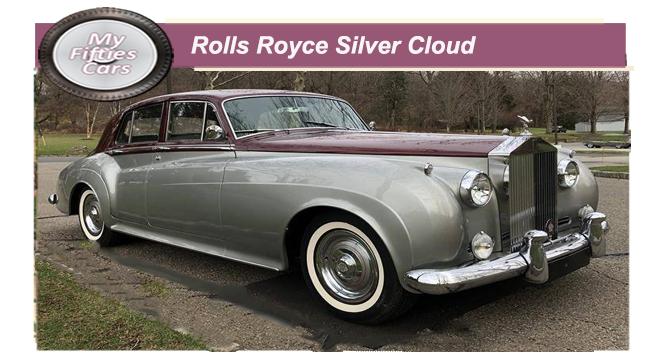 The Silver Cloud, released in April 1955 and remaining in production for more than ten years, was the entry-level Rolls Royce during that exciting period for the auto industry.
The Silver Cloud, released in April 1955 and remaining in production for more than ten years, was the entry-level Rolls Royce during that exciting period for the auto industry.
 The design of the Roll Royce Silver Cloud created by J. P. Blatchley, the company’s, talented in-house designer marked a substantial change in direction from the pre-war models, even from its predecessor, the Silver Dawn, whose design features primarily derived from the prewar period.
The design of the Roll Royce Silver Cloud created by J. P. Blatchley, the company’s, talented in-house designer marked a substantial change in direction from the pre-war models, even from its predecessor, the Silver Dawn, whose design features primarily derived from the prewar period.
 Another indicator of increasing levels of range rationalisation within Rolls-Royce was the fact that it's design counterparts, the Bentley S1 bore compelling similarities to the Silver Cloud, with the usual exception being its radiator grille.
Another indicator of increasing levels of range rationalisation within Rolls-Royce was the fact that it's design counterparts, the Bentley S1 bore compelling similarities to the Silver Cloud, with the usual exception being its radiator grille.
 Comments in the media on the Rolls-Royce Silver Cloud, especially the Series II version, were far from complementary, wiht some pundits going as far as claiming that the model was “one of the last to be worthy of the description as the "best car in the world",” a self-praising accolade which Rolls-Royce were increasingly inclined to use in their advertising.
Comments in the media on the Rolls-Royce Silver Cloud, especially the Series II version, were far from complementary, wiht some pundits going as far as claiming that the model was “one of the last to be worthy of the description as the "best car in the world",” a self-praising accolade which Rolls-Royce were increasingly inclined to use in their advertising.
![]()

 The Silver Cloud was the first Rolls-Royce to have its body produced in-house, although it still retained a separate chassis.
The Silver Cloud was the first Rolls-Royce to have its body produced in-house, although it still retained a separate chassis.
The company's thinking was that, unlike most unitary construction rivals' cars, buyers could have a unique body fitted if they wanted one without too much re-engineering.
This development also meant that the chassis could be used for other projects within Rolls-Royce, perhaps the most highly regarded of which was the beautiful Bentley Continental S, launched in 1955, while it also formed the basis of more conventional Bentleys, including the Si and S2 saloons.
The new Silver Clouds were initially available with the 4887cc (298 cu in) inlet-over-exhaust valve six-cylinder engine, which was initially fitted in the Bentley Mk VI and Rolls-Royce Silver Dawn.
As was to be expected  from a car of this stature, the Silver Cloud came with all the luxury features including a traditional Rolls Royce interior, including a veneered dashboard and deeply upholstered leather chairs.
from a car of this stature, the Silver Cloud came with all the luxury features including a traditional Rolls Royce interior, including a veneered dashboard and deeply upholstered leather chairs.
Further luxury adornments included GM's Hydramatic automatic transmission fitted as standard, plus power steering and optional air conditioning.
![]()
The Mark II version of the Silver Cloud II was released in late 1959, continuing until 1962 when it was replaced by the final version, the Silver Cloud III.
The Mark II was significantly faster and more powerful than the Mark I versions, thanks to being fitted with a V8 engine.
 Nobody knew exactly how potent the Mark II was, due to Rolls Royce’s reticence to provide performance figures for their vehicles during the Fifties and Sixties,
Nobody knew exactly how potent the Mark II was, due to Rolls Royce’s reticence to provide performance figures for their vehicles during the Fifties and Sixties,
The significant difference between the II and III versions was the twin headlamps, the rest of the body remaining unchanged.
 There were several major ulterior motives in doubling the number of headlamps- the first to increase levels of illumination, the second to the vehicle to meet the most recent North American lighting regulations, and lastly to test the layout for the soon to be launched Rolls Royce Silver Shadow.
There were several major ulterior motives in doubling the number of headlamps- the first to increase levels of illumination, the second to the vehicle to meet the most recent North American lighting regulations, and lastly to test the layout for the soon to be launched Rolls Royce Silver Shadow.
With the launch of the Silver Shadow in 1965, the Silver Cloud was phased out, having served Rolls Royce well for just over a decade.


